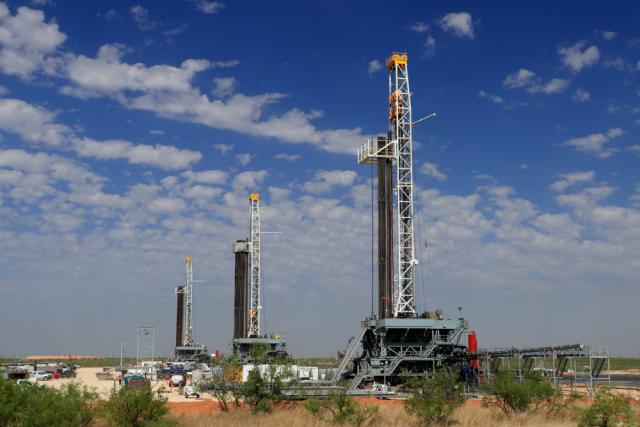
Oil and gas companies and oilfield service providers are preparing to release their latest quarterly earnings and updated operational and spending plans. (Source: G.B. Hart/Shutterstock.com)
SM Energy Co. has raised its mid-point production guidance for the second time amid plans to spend less for the year as the U.S. shale player aims to stay within cash flow.
The Denver-based company, which has operations in the Permian Basin and South Texas, said July 18 it increased full-year production guidance at the midpoint to between 47 million and 47.8 million barrels of oil equivalent per day (MMboe/d), up about 1%. The company also lowered its planned capex for the year by 1% at the midpoint to between $1 billion and $1.05 billion, assuming it spends no more than $80 million per month through the end of the year.
An early look at the company’s second-quarter 2019 production shows activity is already moving in that direction. Production was up 16% to 12.4 MMboe as Permian Basin and South Texas wells outperformed expectations, and capital spending of $261 million fell below guidance.
“Our results so far in 2019 and revised guidance indicate that we are on track to deliver on our business plan priorities: achieving growth within discretionary cash flow, de-levering our balance sheet and proving up additional drilling inventory on our existing acreage,” Jay Ottoson, president and CEO of SM Energy, said in a statement.
The update comes as oil and gas companies and oilfield service providers prepare to unveil their latest quarterly earnings and updated operational and spending plans. For the most part, independents have been producing more but spending less, looking to please shareholders and improve finances.
Cowen & Co., a U.S. financial services firm, said indications from the E&P companies it tracks point to a 5% drop in drilling and completions (D&C) spending this year, compared to 2018, according to a recent report from Reuters. Independent producers were expected to trim spending by 11%, while oil majors were expected to spend about 16% more.
Although shale players have been using improved D&C techniques such as longer laterals and high-intensity fracks to get more oil and gas from reservoirs, inability to consistently improve cash flow, reduce debt and turn profits has left investors with a negative view of the industry.
The negative sentiment is reflected in stock prices of E&P companies that have tanked in recent years and moves by some to ditch oil- and gas-focused investments.
But the industry’s efforts to do better have been noticed.
CapitalOne Securities Inc. analysts viewed SM Energy’s news as positive, saying it suggests “continued capital efficiencies and strong well performance in both the Permian and Eagle Ford.”
An analyst at Williams Capital Group shared similar thoughts.
“Considering the low expectations in SM as witnessed by the significant underperformance (down 21.2% over the past month vs. peers which are only down 1.4% on average) and the discounted valuations (a roughly one turn 2019 and 2020 EV/EBTIDA discount to peers), we would expect SM shares to outperform on the positive overall pre-announcements and guidance updates,” Gabriele Sorbara, principal and senior equity analyst at Williams Capital Group, wrote in a note July 18.
SM Energy’s Midland Basin production was above the analyst’s estimates, coming in at 56,500 barrels per day.
In May, the company said its first Middle Spraberry test in the Midland sub-basin’s RockStar area reached a 30-day peak IP rate of about 1,000 barrels of oil equivalent per day (boe/d) at 86% oil.
The following month SM Energy reported two Rockstar area wells testing the Dean and Wolfcamp D intervals had strong 30-day peak IP rates, producing about 1,550 boe/d and 1,400 boe/d, respectively.
“These zones are additive to the company’s inventory,” Sorbara said in the note.
The company has at least 12 years of inventory each in the Midland and the Eagle Ford.
RELATED: SM Energy Works To Prove Up Permian Basin, Austin Chalk Inventory
SM Energy expects to produce between 12 MMboe and 12.2 MMboe (about 43% oil) during the third quarter. The company said second-half production guidance “includes the effect of anticipated production shut-ins of up to 1.5 MMBoe due to offset operator activity, simops [simultaneous operations] and other impacts” and “assumes ethane rejection (compared with ethane processing in the first half of 2019), which reduces overall barrel equivalent production volume.”
The company will release its second-quarter 2019 earnings report Aug. 1.
Velda Addison can be reached at vaddison@hartenergy.com.
Recommended Reading
Hess Corp. Boosts Bakken Output, Drilling Ahead of Chevron Merger
2024-01-31 - Hess Corp. increased its drilling activity and output from the Bakken play of North Dakota during the fourth quarter, the E&P reported in its latest earnings.
Matador Resources Announces Quarterly Cash Dividend
2024-04-18 - Matador Resources’ dividend is payable on June 7 to shareholders of record by May 17.
Petrie Partners: A Small Wonder
2024-02-01 - Petrie Partners may not be the biggest or flashiest investment bank on the block, but after over two decades, its executives have been around the block more than most.
CEO: Coterra ‘Deeply Curious’ on M&A Amid E&P Consolidation Wave
2024-02-26 - Coterra Energy has yet to get in on the large-scale M&A wave sweeping across the Lower 48—but CEO Tom Jorden said Coterra is keeping an eye on acquisition opportunities.
NGL Growth Leads Enterprise Product Partners to Strong Fourth Quarter
2024-02-02 - Enterprise Product Partners executives are still waiting to receive final federal approval to go ahead with the company’s Sea Port Terminal Project.






